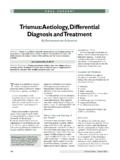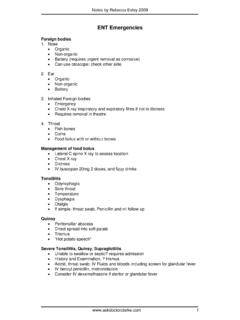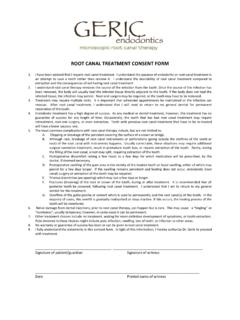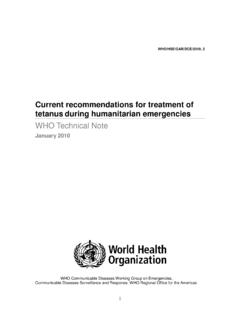Transcription of Deep Neck Space Infections - ENT Lectures
1 deep neck Space Infections deep neck Space Infections Disclaimer: The pictures used in this presentation and its content has been obtained from a number of sources. Their use is purely for academic and teaching purposes. The contents of this presentation do not have any intended commercial use. In case the owner of any of the pictures has any objection and seeks their removal please contact at . These pictures will be removed immediately. The fibrous connective tissue that constitutes the cervical fascia varies from loose areolar tissue to dense fibrous bands. This fascia serves to envelope the muscles, nerves, vessels and viscera of the neck , thereby forming planes and potential spaces that serve to divide the neck into functional units.
2 It functions to both direct and limit the spread of disease processes in the neck . The cervical fascia can be divided into a simpler superficial layer and a more complex deep layer that is further subdivided into superficial, middle and deep layers. The superficial layer of cervical fascia ensheaths the platysma in the neck and extends superiorly in the face to cover the mimetic muscles. It is the equivalent of subcutaneous tissue elsewhere in the body and forms a continuous sheet from the head and neck to the chest, shoulders and axilla. The superficial layer of the deep cervical fascia is also known as the investing layer.
3 It follows the rule of twos it envelops two muscles, two glands and forms two spaces. It originates from the spinous processes of the vertebral column and spreads circumferentially around the neck . It covers sternocleidomastoid and trapezius muscles, encloses the submandibular and parotid glands. It also covers the anterior bellies of the digastrics and the mylohyoid, thereby forming the floor of the submandibular Space It forms the Space of the posterior triangle on either side of the neck and the suprasternal Space of Burns in the midline. The middle layer of the deep cervical fascia is also known as the visceral fascia It has two subdivisions, the muscular division, which surrounds the infrahyoid strap muscles, and the visceral division, which envelops the pharynx, larynx, esophagus, trachea, and thyroid gland.
4 The visceral division passes inferiorly into the upper mediastinum where it is continuous with the fibrous pericardium and covers the thoracic trachea and esophagus. The deep layer of the deep cervical fascia originates from the spinous processes of the cervical vertebra and the ligamentum nuchae. At the transverse processes of the cervical vertebra, it divides into an anterior alar layer and a posterior prevertebral layer. The alar fascia extends from the base of the skull to the second thoracic vertebra The prevertebral fascia lies just anterior to the vertebral bodies and extends the entire length of the vertebral column.
5 The carotid sheath is a fascial layer that is associated with but is anatomically separate from the previously described layers It receives contributions from all three layers of deep cervical fascia. It contains the carotid artery, internal jugular vein and vagus nerve It continues from the skull base through the neck along the anterior surface of the prevertebral fascia, and enters the chest behind the clavicle Spaces Spanning the Entire Length of the neck The superficial Space is located between the superficial fascia and the superficial layer of the deep fascia This potential Space lies superficial and deep to the platysma and contains loose areolar tissue, lymph nodes.
6 Nerves and vessels the most significant of which is the external jugular vein This Space is most commonly involved with superficial cellulitis of the neck , but if abscess formation does occur, this will present with obvious fluctuance, erythema, warmth and tenderness The deep neck spaces that run the entire length of the neck include: Retropharyngeal Space Danger Space Prevertebral Space Visceral vascular Space Retropharyngeal Space It occupies the Space posterior to the pharynx and esophagus. Its anterior wall is made up of the buccopharyngeal fascia superiorly and the visceral division of the middle fascia inferiorly The posterior wall is the alar layer of the deep fascia The lateral boundary is the carotid sheath.
7 This Space extends from the base of the skull to the level of the first and second thoracic vertebra Danger Space Posterior to the retropharyngeal Space lies the danger Space So named because it contains loose areolar tissue and offers little resistance to the spread of infection It is the Space between the alar layer and prevertebral layer of the deep fascia Runs from the skull base to the diaphragm Visceral Vascular Space It is the potential Space within the carotid sheath. IT contains little areolar tissue and is resistant to the spread of infection. Termed the Lincoln s highway It extends from the base of skull into the mediastinum.
8 Receives contributions from all three layers of deep fascia It can become secondarily involved by infection in any other deep neck Space by direct spread.. Suprahyoid Spaces The submandibular Space The parapharyngeal Space The peritonsillar Space The masticator Space The Parotid Space The submandibular Space Bounded by the mandible anteriorly and laterally The lingual mucosa superiorly The hyoid postero-inferiorly The superficial layer of the deep cervical fascia inferiorly The mylohyoid muscle divides this Space into a superior sublingual Space and an sub-mylohyoid Space The sublingual Space contains loose areolar tissue, the hypoglossal and lingual nerves, the sublingual gland and Wharton s duct.
9 The submylohyoid Space contains the anterior bellies of the digastrics and the submandibular glands. These two subdivisions freely communicate around the posterior border of the mylohyoid Early appearance of patient who has Ludwig s angina with characteristic submandibular woody swelling Parapharyngeal Space The skull base superiorly Pterygo- mandibular raphe anteriorly Parotid Boundaries Hyoid Bone Inferiorly Mandible Prevertebral Fascia Posteriorly Bucco-pharyngeal fascia medially Medial Pterygoid PPS Submandibular Space Masticator Space Retropharyngeal Space Parotid Space Pre-Styloid Fat, muscle.
10 Lymph nodes and connective tissue Tonsillar fossa Medial Pterygoid plate Post-Styloid Carotid sheath 9th, 10th & 12th Cranial Nerves Retropharyngeal Abscess in Children Retropharyngeal abscess Most common deep neck abscess Retropharyngeal lymph nodes tend to involute with age Source of infection suppurative process in nose, nasopharynx, sinuses and adenoids 96% abscesses occur prior to 6 years of age Symptoms Fever Enlarged Cervical LNs Post. Pharyngeal wall buldge Trismus Torticollis Irritability Poor oral intake Sore throat Dysphagia Drooling Laryngeal oedema Respiratory distress Lateral radiograph of the neck Retropharyngel Space Abscess in Adults Retropharyngeal abscess in the adult is typically caused by.









